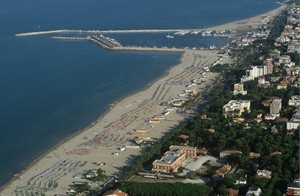Giulianova
| Informazioni |
|---|
| Mappa e contatti |
The name of the ancient Roman settlement Castrum Novum was changed to Castel San Flaviano in honour of Constantinople's Patriarch. After having been subjected to the numerous plunders and incursions of the Saracens, Giulianova was reconstructed during the 14th century by the Duke Giuliantonio Acquaviva and was named after him Iulia Nova. The evolution of its name already suggest how rich the history of this Riviera town has been, which is today an important strategical centre for industry and tourism.
As many other towns on the Teramo coast, Giulianova consists of two parts: a modern one extending along the seaside and the historical centre, which was built in the 14th century on top of the hill. The major historical-cultural sites are concentrated in the latter: to start with the Renaissance style Dom of San Flaviano, which was constructed between the late 15th and the early 16th century. Its gigantic cupola, that dominates the entire town, once had an important strategic role as it could be seen from the sea thanks to the sunlight reflecting on its blue-green majolica tiles. In the inside the Baptism of Jesus and the Baptistery with angels flying in the basin are of particular interest.
Worth a visit are also the 16th-century Church of Sant'Antonio and of Sant'Anna, the Cappella gentilizia dei Bartolomei, which has bas-reliefs and sculptures of Pagliaccetti, and the Donjon “il Bianco”, the last to remain from the town walls that had been built in the Middle Ages to defend the town.
The Belvedere of Piazza Vittorio Emanuele with its view on the sea and the enchanting Sanctuary of the Madonna dello Splendore are both very evocative sites. The latter is a place of worship and devotion; here the population of Giulianova celebrates each year the apparition of the Virgin Mary to a humble peasant that according to the tradition would have occurred in year 1557 .
In addition to the beauty of its historical centre and thanks to the presence of the important Splendore Art Musem, attached to the Sanctuary, the Archeological Museum Torrione "Il Bianco", the Raffaello Pagliacetti sculpture exhibition, the Bartolomei Chapel and the House-Museum of Gaetano Braga.

















